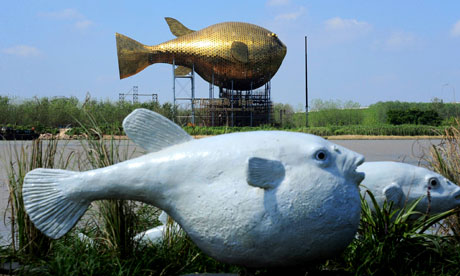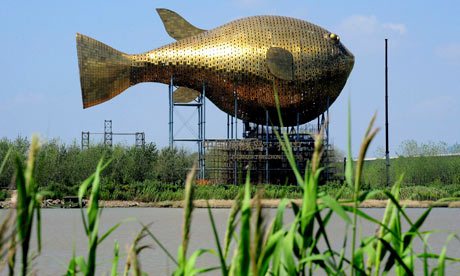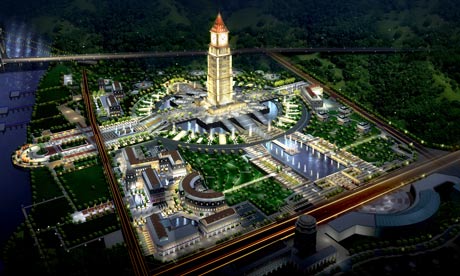Jonathan Kaiman in Beijing

A viewing tower in the shape of a giant copper puffer fish is seen behind a sculpture of puffer fish in Yangzhong county
A city in eastern China has spent 70m yuan (£7.1m) on building a giant bronze statue of a puffer fish, drawing accusations of graft and profligate state spending.
Yangzhong, a county-level city in Jiangsu province, which is known for its puffer fish – a popular delicacy in China and Japan – built the 62 metre-tall (203ft) "puffer-fish pagoda" to mark the opening of a horticultural exhibition, the newspaper Modern Express reported on Friday.
Pictures online show the statue standing on the city's Xisha Island near a river, silhouetted against a sunset.
The statue is 90 metres long by 44 metres wide, and weighs 2,100 tonnes, according to the report.
It is covered with 8,920 bronze plates and multicoloured LED bulbs, which are activated at night for an elaborate light show.
Visitors can take a lift up to a basketball court-sized viewing platform beneath the fish's abdomen.
The statue is the largest steel framework sculpture in China, the report quoted local officials as saying; by some metrics, it may be the largest in the world.
Visitors can take a lift up to a basketball court-sized viewing platform beneath the fish's abdomen.
The statue is the largest steel framework sculpture in China, the report quoted local officials as saying; by some metrics, it may be the largest in the world.
The city has applied for a Guinness world record.

The giant copper puffer-fish on Xisha Island in Jiangsu province
The newspaper suggested that the construction process was tainted by corruption – by comparing estimates by construction experts, it found that the statue's raw materials should have cost 10m yuan.
"As for what constitutes the other 60m yuan in expenditures, this journalist fails to understand," it said.
President Xi Jinping has launched a nationwide crackdown on ostentatious displays of money, which, by highlighting the country's extreme wealth gap, are widely considered a latent trigger of social unrest.
The blowfish statue "is absolutely not worth [the money] – it's just another classic face project, even a corrupt project", wrote a user on Sina Weibo, the country's most popular microblog.
President Xi Jinping has launched a nationwide crackdown on ostentatious displays of money, which, by highlighting the country's extreme wealth gap, are widely considered a latent trigger of social unrest.
The blowfish statue "is absolutely not worth [the money] – it's just another classic face project, even a corrupt project", wrote a user on Sina Weibo, the country's most popular microblog.
"Yangzhong's leaders are brain damaged. Let's just wait for the investigation."
Similarly expensive, yet minimally functional projects are common in China.
Similarly expensive, yet minimally functional projects are common in China.
One small city in landlocked Anhui province is building a hotel shaped like a table-tennis bat.
In 2010, another city in south-east China built the world's largest mechanical clock.

An artist’s impression of Ganzhou’s Harmony park and the 113-metre high clock built by Smith of Derby.
The Yangzhong government initially expected to spend 80m yuan on the puffer fish, and it was completed under budget, the newspaper quoted two construction managers as saying.
The total cost included peripheral projects such as renovating a nearby dock, fixing a road, installing water treatment systems and building an electricity shed for the elevator, they said.
The Yangzhong government did not announce the project on its official webpage and could not be reached for comment.
The Yangzhong government did not announce the project on its official webpage and could not be reached for comment.







0 comments:
Post a Comment